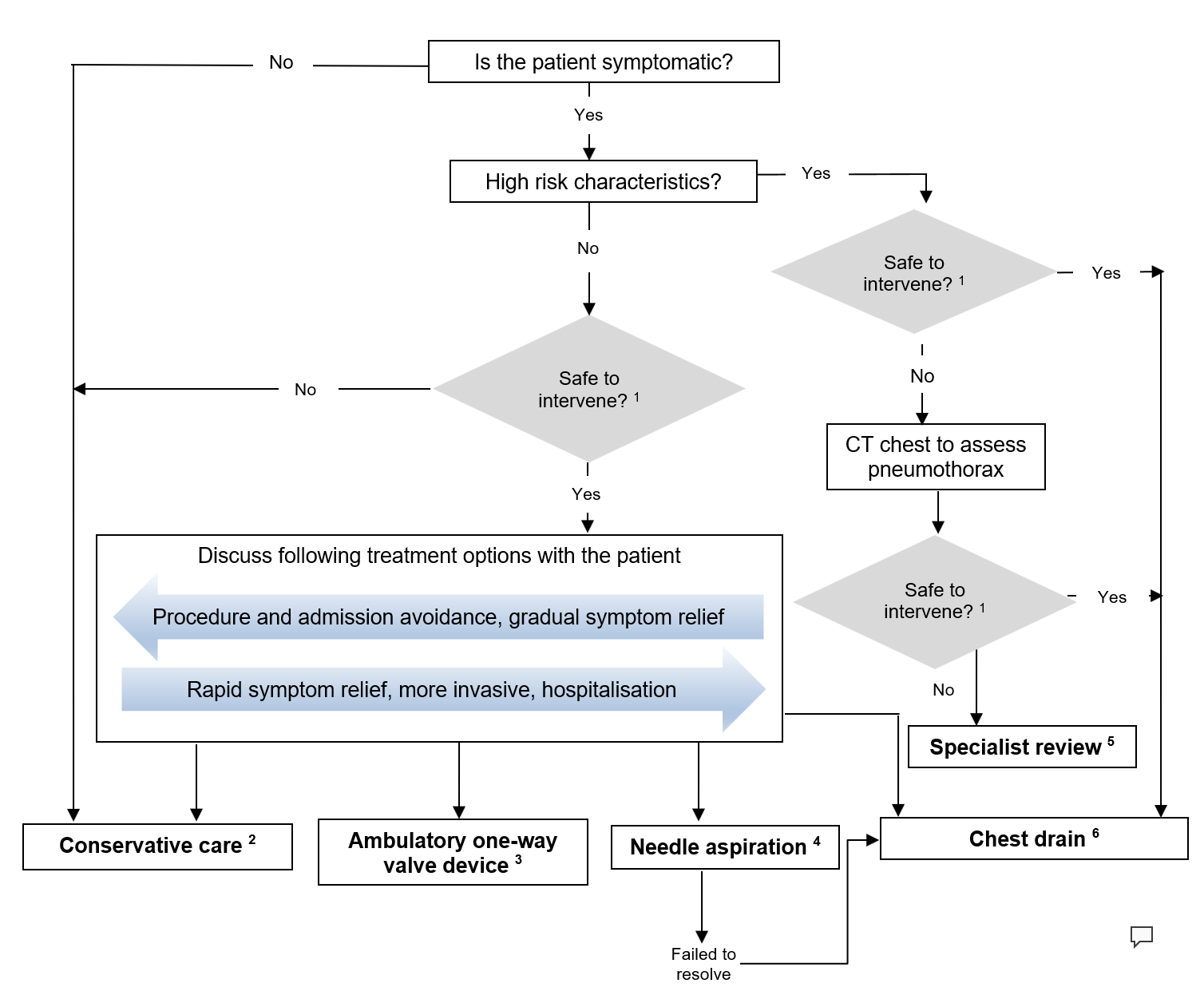DO NOT USE - ALL INFORMATION LIKELY INCORRECT IF NOT ACTIVELY DANGEROUS
Please use current guidelines available on the UHNM intranet for patient treatment
Please use current guidelines available on the UHNM intranet for patient treatment
DEFINITION
Air accumulating in pleural space:
- Primary spontaneous pneumothorax (PSP)
- aged <50 yr, absence of suspected lung disease
- Secondary spontaneous pneumothorax (SSP)
- aged ≥50 yr or significant smoking history or evidence of chronic lung disease on history, examination or CXR
RECOGNITION AND ASSESSMENT
Symptoms and signs
- Sudden onset, occasionally insidious:
- chest pain (unilateral)
- breathlessness
- Resonance on percussion, with reduced vocal fremitus and breath sounds (if significant)
- Establish if chronic lung disease (SSP) and identify presence of high risk characteristics
High risk characteristics
- Haemodynamic compromise (tension pneumothorax)
- Significant hypoxia
- Bilateral pneumothoraces
- Underlying lung disease
- Aged >50 yr with significant smoking history
- Haemopneumothorax
Investigations
- PA chest X-ray - to help determine degree of lung collapse
- In patients with complex bullous disease and partially pleurodesed lung or if lungs are obscured by surgical emphysema, consider plain CT chest before invasive pleural interventions
If patient in extremis, very breathless with circulatory compromise, and trachea or mediastinum (apex beat) displaced, consider TENSION PNEUMOTHORAX (very rare). Give oxygen (10 L/min) through a high concentration (60-100%) mask.
Insert a large bore cannula of at least 4.5 cm in length into second anterior intercostal space, midclavicular line, then insert intercostal tube - see Intercostal tube drainage guideline. Remove emergency cannula when bubbling in underwater seal system confirms intercostal tube system functioning
TREATMENT
Follow Pneumothorax management pathway
PNEUMOTHORAX MANAGEMENT PATHWAY

1 Safe to intervene
- It is safe to intervene if ≥2 cm rim from apex or lateral chest wall on chest X-ray
2 Conservative care
- For minimally symptomatic (i.e no significant pain or breathlessness and with no physiological compromise) or asymptomatic PSP, regardless of size of lung collapse
- PSP: discharge and refer to pleural clinic (call 75353) or respiratory team for regular follow-up within 1-2 days and then every 2-4 days until stable, and every 2-4 weeks thereafter
- if pneumothorax or symptoms increasing, admit and insert chest drain - see Intercostal tube drainage guideline
- if outpatient pleural service not available, discuss with respiratory team
- SSP: admit and monitor as inpatient
- discharge when stable, with follow-up in pleural clinic (call 75353) or respiratory outpatients in 2-4 days with further follow-up until lung fully reinflated
- if pneumothorax or symptoms increasing, admit and insert chest drain - see Intercostal tube drainage guideline
3 Ambulatory one-way valve device
- Refer to pleural team (call 75353) for device insertion
- Follow-up every 2-4 days
- Remove device once lung almost fully inflated and further follow-up as required
- if pneumothorax or symptoms increasing, admit and insert chest drain - see Intercostal tube drainage guideline
4 Needle aspiration
- See Pleural aspiration of air guideline
- If resolved, discharge and follow-up in pleural clinic (call 75353) or respiratory outpatients in 2-4 weeks
- if unresolved or patient still symptomatic and >2.5 L of air aspirated on first attempt, proceed with chest drain insertion - see Intercostal tube drainage guideline
5 Specialist review
- Discuss with radiology if safe to insert chest drain - see Intercostal tube drainage guideline or if CT guided procedure required
- If not possible to insert chest drain refer to pleural team (call 75353) or respiratory team
6 Chest drain
- See Intercostal tube drainage guideline
- Refer to pleural team (call 75353)
- If recurrent pneumothorax or first episode in high risk patient in whom recurrence could be life-threatening, discuss with thoracic surgeons
- Refer for consideration of acute thorax surgery if
- presenting with tension pneumothorax
- high risk occupation (e.g. airline pilot, diver)
Review
- Ensure drain is swinging at all times
- Always keep underwater seal bottle below waist level
- Do not clamp chest tube unless advised by pleural team or thoracic surgeon
- Consider chest X-ray - if lung not re-inflated and not bubbling in underwater bottle
- Try to remove block or kink - if unsuccessful, contact pleural team
Non-resolution
- Refer to pleural or respiratory team (call 75353)
- Failure to reinflate - possible causes include:
- persistent air-leak
- displaced/blocked tube
- broncho-pleural fistula
- underlying lung disease
- Use high volume/low pressure suction, starting at -1.0 to -2.0 kPa (-10 to -20 cm H2O) as tolerated
- Early discussion with thoracic surgeons, refer if:
- pneumothorax fails to resolve after 5 days of above management or
- after 3 days if patient has chronic lung disease
- Patients with secondary spontaneous pneumothorax that are unfit for surgery consider:
- medical pleurodesis (see Medical pleurodesis guideline)
- ambulatory management with a one-way valves devices (Heimlich valve/flutter bag etc.) and digital drain with close follow-up in the pleural clinic
Removal
- Bubbling stopped for ≥24 hr after complete or almost complete lung re-inflation
- Cut drain-securing suture and withdraw tube while patient holds breath in expiration
- Close wound with sutures and reapply dressing
FOLLOW UP
- Refer all patients with spontaneous pneumothorax to pleural or respiratory team (call 75353) for appropriate follow up as detailed above
- Refer to cardiothoracic outpatients for consideration of elective surgery to prevent recurrence if:
- at risk profession, e.g. diver, airline pilot or in military
- second ipsilateral or first contralateral pneumothorax
- tension pneumothorax
No air travel until full lung re-inflation on CXR
Last reviewed: 2024-05-01